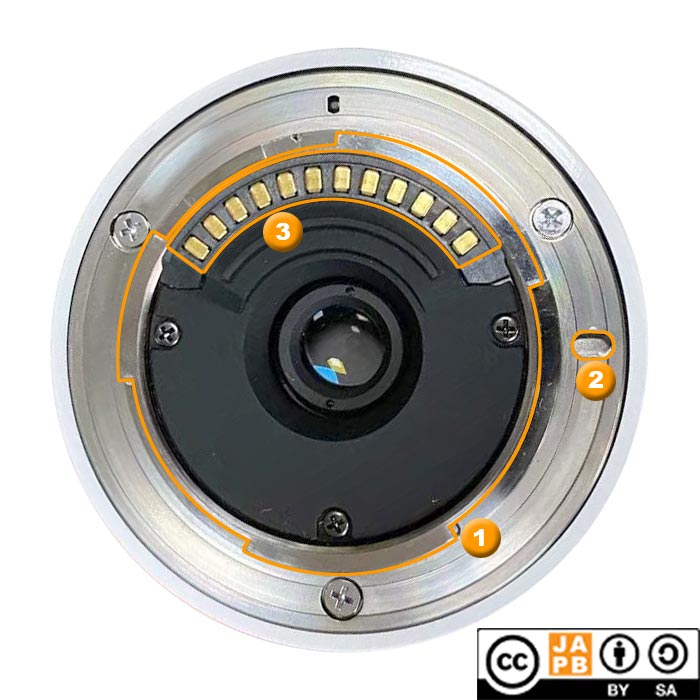Pekka Buttler (Updated 5/2025)
Basic Information on the Nikon 1 mount:
The Nikon 1 mount was introduced together with the Nikon 1 camera in September 2011. The Nikon 1 differs from many other interchangeable lens compact mirrorless cameras (such as the Sony NEX series, The Olympus PEN-series, or the Canon EOS M series) in that it uses a smaller sensor (referred to by Nikon as the Nikon CX format (in contrast to DX=APS-C and FX=full-frame).
While designed as an independent, full, super compact system, Nikon also offered a dedicated “FT1” adapter to allow the use of Nikon F format lenses (albeit with a massive, 2,7 x crop factor). Although Nikon introduced several models with ever-improving specifications, Nikon discontinued the Nikon 1 series in 2018.
Nikon 1 mount specifications and identification
Mount type: Bayonet mount (lens release on camera)
Flange focal distance: 17,00 mm
Sensor size: 13.2 mm x 8.8 mm (‘Nikon CX’)(3:2 aspect ratio)
Mount communication:
• electronic only: focusing, zoom, aperture (camera-to-lens), distance information, lens data (lens-to-camera)
• 12 electronic contacts (springs-loaded at the camera-end)

[1] Three-pronged male bayonet mount
[2] Locking groove at 03:00
[3] Bank of 12 electronic contacts between 10:30 and 01:30
Adapting Nikon 1 lenses
Due to the short flange focal distance of Nikon 1 lenses, the list of bodies you could theoretically adapt Nikon 1 lenses to is very short: Nikon Z, Pentax Q and Samsung NX mini (the later two have been discontinued)
Furthermore, as the lenses are fully electronic, you won’t be able to use them without a dedicated smart adapter. As the flange focal distance advantage of the Nikon Z is only 1 mm shorter than that of the Nikon 1, such an adapter is likely impossible to construct.
Hence, your only chance to use Nikon 1 lenses is to get a Nikon 1 camera.
Adapting to Nikon 1 cameras
The Nikon 1 mount has a very short flange focal distance, which could make it a tempting camera for adapting a lot of different legacy lenses to. As a result, a range of third party adapters are available.
Problematically, the minuscule sensor makes this a relatively unattractive proposition, except for a number of special cases:
• Turning tele lenses into Ultra-tele lenses
• Using those lenses that project image circles smaller than APS-C.
Among that later use case three lens families deserve special mention: C-mount lenses, Pentax-110 lenses and Olympus PEN-F lenses (although these are more well served by an MFT or APS-C sensor).
However, as brought to my attention by a reader1, the question of adaptability is not always about sensor sizes and flange focal distances, as also the camera’s software needs to be willing to play ball with non-standard lenses. And in this case Nikon seems to have made it more difficult to adapt legacy lenses, meaning that the Nikon 1 is not a generally attractive platform for adapting lenses.
Footnotes:
- This is the reader’s account of using the Nikon 1 as a platform to adapt to. “While dumb adapters from a variety of mounts to Nikon 1 exist, using them is nothing but pain since the brainiacs at Nikon disabled AF confirmation, peaking, magnification AND LIGHT METERING if there’s no electronic signal from the lens. People say latest models allow metering; my J1 surely doesn’t. Smart adapters were only ever produced in Russia by a company called GFoto; I used to own one and it worked fine, enabling metering, focus confirmation and magnification but it stopped working after about a year; not sure what the issue was, but adapter chips from this company were generally considered failure-prone. Those smart adapters are not manufactured anymore; there’s one person in Belarus who has some stock left, but he’s only reachable through an obscure local internet forum. So, for all intents and purposes, there is no smart adapter anymore, and it means using your digital Nikon 1 camera with sunny16 rule or external meter. When it worked, I’ve enjoyed using C-mount lenses (including a microscope) with it. I wanted to try super16 cine lenses on it because the sensor size is just right, and there is plenty of good super16 optics including wide angle, but I never got to it, and with the smart adapter dead, I never will […] Sure, I can measure the light with my eyes, sunny16 or external meter, but my Sony NEX-5 is only marginally bigger and offers a much better user experience so what’s even the point?” ↩︎